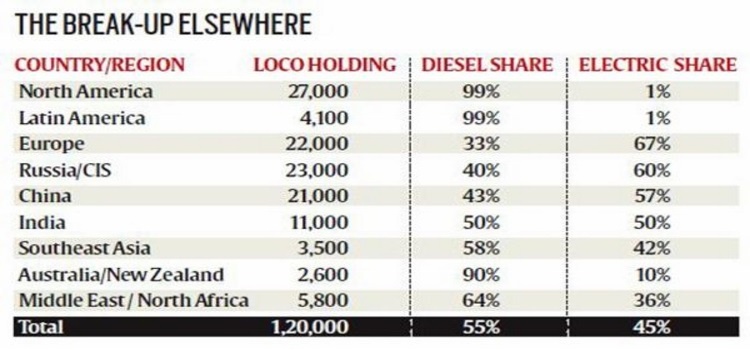
The chief of the Prime Minister’s Economic Advisory Council Bibek Debroy has now presented a paper saying the policy of 100 per cent electrification needs more study.
Last year, the government decided to electrify the entire broad gauge network of the Indian Railways by 2022. Over the years, the rate at which electrification has progressed has been determined both by how much money has been available, as well as the returns on investment that the Railways got from operations on these lines. The more the traffic, the better are the returns on electrified routes.
However, all electrified routes also ran diesel trains because in a network that has both tractions, total segregation is neither possible nor viable. The chief of the Prime Minister’s Economic Advisory Council Bibek Debroy has now presented a paper saying the policy of 100% electrification needs more study.
Electrification is cheaper, but…
Globally, the cost of operations has been cheaper on electrified routes. However, for it to be cheaper than diesel traction in the overall transport economics, the total traffic on that route must cross a certain threshold of Gross Tonne Kilometres (GTKM). This is the unit of measurement of total weight of locomotives and coaches carried per kilometre in a year on a route. A committee of experts headed by retired Railway Board Member (Traffic) C M Khosla determined that value at 53 GTKM in 2002. The World Bank has in the past suggested around 52 GTKM.
This is because unlike diesel, an electric engine requires heavy overhead equipment to run. Capital expenditure for this electrification is over Rs 1 crore per kilometre. The only way to recover this cost is by running trains — and if the number of trains does not cross a certain threshold, the calculation for the transporter goes into negative territory. On that parameter, the average GTKM value of currently electrified routes is around 45.
It, therefore, makes more sense to electrify routes that see heavy traffic volumes — which is what the Railways have done over the years. This is also why there is no talk of electrifying the 2,000-odd km of metre gauge and narrow gauge lines; the stress is more on converting them to broad gauge first. For the same reason, of the 22,019 km of the busiest double/multiple lines, a little over 82% already stand electrified. And everyone seems to agree that electrifying the remaining 3,842 km is a good idea.
The single-line problem
Of the 67,000-odd route km of railway network (narrow, meter gauges included), 39,658 km are single lines with mostly very poor train traffic volumes, almost less than half of the heavy-density electrified routes. This portion also includes the “uneconomic branch lines”. When the Railways say they wants to electrify the entire broad gauge network, they mostly mean the remaining single lines on the network.
Due to the poor density of both freight and passenger traffic, the Railways have not found financial justification for the electrification of these routes. Data show only 28%, or 7,190 km, of single lines are electrified — that too, due to operational reasons. With the stress on network capacity expansion, most single lines may be doubled in the future. However, the doubling will have a bearing on easing operational bottlenecks more than increasing traffic volumes — which is mainly determined by economic activity.
So the dilemma is, should the Railways also electrify these routes at a projected loss?
The cost breakup
The Railways spend around Rs 16,000 crore in diesel bills, and around Rs 10,000 crore in power bills, annually. It buys diesel at state rates, and power at an average per-unit cost of Rs 6.50.
Of the Rs 16,000 crore diesel bill, around Rs 8,000 crore are taxes. While the tax component varies from state to state, the Railways on average pay around 53% of the total diesel bill as taxes. Electric traction is more or less tax-neutral. The transporter is also purchasing directly from power producers at best-available rates per unit.
So, half of the money the Railways want to save is taxes ploughed into the economy that go into welfare schemes of the state, while most of the rest go to oil PSUs.
Also, stakeholders say, if GST is implemented on diesel, the Rs 8,000 crore the Railways pay in taxes would be almost halved even if the rate is 28%. It remains to be seen if the Railways wait for the government’s GST move before taking a final call on the choice of traction.
The power gain
The biggest argument put forth in favour of total electrification is the yearly saving to the tune of Rs 8,000-10,000 crore on the fuel bill. However, calculated at present rates, the total capital cost of electrification could be around Rs 40,000 crore. The cost of replacing the current fleet of around 5,800 diesel locomotives could be around Rs 50,000 crore. Taken with the maintenance infrastructure needed, the total figure may be Rs 1 lakh crore.
The Railways would have to borrow much of this money, while factoring in the cost of depreciation of assets. The servicing of this debt is an issue that needs to be looked at closely, experts say.
Environment, flexibility
If the Railways consume around 2,776 million litres of diesel, they currently require around 15,000 units of electricity, mostly coal-based thermal power. Total electrification might require the generation of an estimated 1,800 MW of additional power. The Railways have traditionally justified dual traction of diesel and electric on a variety of grounds, including, importantly, operational flexibility. During times of disaster or war, diesel engines have been more reassuring. While talking about 100% electrification, policymakers have discussed keeping a small fleet of diesel locomotives handy for such purposes.
